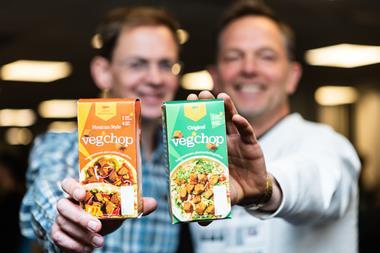This time last year, you couldn’t move for Union Flags. Jubilee excitement meant supermarkets looked like street parties, as suppliers and retailers slapped red, white and blue on any surface that would take a label.
What a difference a year makes. The bunting is gathering dust in stockrooms, while the rain that washed out many Jubilee street parties has forced even the most patriotic brands to mix their supply of British wheat with foreign imports.
The first high-profile casualty was Hovis, which in January reneged on its commitment to use 100% UK-sourced wheat in its loaves. Then, two weeks ago, The Grocer revealed The Weetabix Food Co had halted production of all but one of its Weetabix Minis lines as it re-engineered its production process to cope with lower-quality British wheat. In the meantime, it is also had to temporarily abandon its British-sourcing pledge and buy in small quantities of wheat from abroad.
And the casualties will keep coming. This week, United Biscuits told The Grocer it had so far managed to keep the wheat in its Digestives 100% British, but expected to soon switch to a blend including imported wheat. And Nestlé Cereal Partners has started using some imported wheat but would not say which of its brands were affected.
These business supply chains have fallen victim to what has been called the worst UK wheat crop in 30 years. The National Association of British & Irish Millers has estimated the total 2012/13 crop (from July 2012 to June 2013) will be 13.3 million tonnes compared with 15.3 million the previous year. But worse than the low yield was the delay in harvesting brought about by the wet weather and the lack of sunshine, which affected quality and meant millers struggled to deliver flour that matched required specifications and consistency.
Wheatabites
- Half the UK’s wheat goes to animal feed and industrial use. Of the remainder, about 60% is used for bread, 12% biscuits, 20% for starch manufacture and the rest as a food ingredient or packaged for retail.
- British wheat has accounted for as much as 87% of the wheat used by millers, but could be as low as 70% this year.
- There are 53 mills in the UK run by 31 companies. The largest - ADM Milling, Allied Mills, Rank Hovis and Whitworths - mill 65% of the UK’s flour.Source: Nabim
The situation will remain a challenge for the supply chain - particularly businesses using specialist wheat - such as the red wheat in Hovis and white in Weetabix. British biscuit suppliers are also being hit hard, as they use a soft wheat grown only in limited quantities outside the UK. One industry insider claims US soft wheat was brought into the country earlier this year by a supplier to make up the shortfall.
Exceptions
But there are a few businesses that have managed to maintain their British wheat sourcing commitment - including Sainsbury’s in-store bread bakeries. With the exception of certain speciality breads, the products sold in 467 in-store bakeries and 487 c-stores is made with 100% British wheat. And the retailer says it remains committed to its sourcing pledge despite the current challenges.
What has made Sainsbury’s situation different from that of many of its rivals is that, rather than source wheat from individual farmers, it is supplied by Camgrain, one of a number of central storage organisations that account for about 10% of UK wheat supply and claim to offer benefits over many single-farmer operations.
While many farmers were forced to leave wheat standing in fields last summer due to the wet summer, Camgrain mitigated some of the effects of the weather.
“We have the infrastructure to deal with a difficult harvest,” says Camgrain MD Philip Darke. This includes drying facilities that give its members the option to cut wheat at a higher moisture level, while drawing from a pool of 500 farmer members across the country, which can help ensure it supplies a consistent blend.
Building a relationship with a single supplier has other advantages, says Ashley Clarkson, associate director at Grant Thornton, which has advised Camgrain. “If you use a mix of suppliers there may be subtle differences in the quality and processing characteristics of the wheat. Also using a single supplier means a business can reduce procurement costs.”
Nonetheless, more buyers will be looking outside the UK this year - particularly as imported wheat is set to cost less than it did last year. Factors including the drought in the US put pressure on supply in 2012, but early signs suggest global prices will fall this year.
“Some manufacturers will use this to their advantage,” says Clarkson, “and may not be in a rush to establish a dedicated UK supply chain.”
2013 crop
And the gloomy predictions for the coming UK crop is unlikely to encourage them to do so either.
There are two main issues with the 2013/14 crop, says Alexander Waugh, director general at the National Association of British & Irish Millers. “First, the wet winter means farmers couldn’t plant when they would normally, so plantings are down as much as 25% on a typical year,” he says. “Secondly, some farmers are saying the growing conditions are not very good and that plants are not looking their best.”
Hovis owner Premier Foods believes late planting and wet conditions will hit yields and is expecting to continue importing European wheat for Hovis.
Some are more upbeat. “If we can have some decent weather to give it a good start, and a nice warm May and June - with a bit of rain - I believe we can get a decent crop,” says Michael Marriage, MD at organic flour supplier Doves Farm.
Let’s hope so. With further patriotic celebrations - this time to mark the 60th anniversary of the Queen’s coronation - it seems only right we fly the flag for British flour. If we can, of course.



















No comments yet